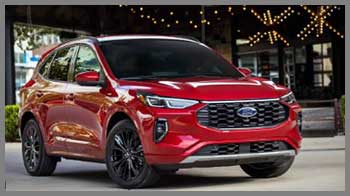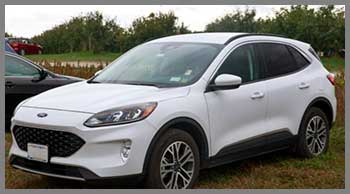
As an automotive enthusiast who’s spent countless hours exploring SUVs, I’ve always been drawn to the versatility and performance of vehicles like the Ford Edge and Jeep Cherokee.
These midsize SUVs promise a blend of comfort, capability, and style, making them popular choices for families and adventurers alike.
In this article, I’ll compare the 2024 Ford Edge and the 2023 Jeep Cherokee to help you decide which SUV best suits your needs.
From performance to practicality, I’ll share detailed insights to guide you toward the right choice.
Comparison Table: Ford Edge Vs. Jeep Cherokee
| Feature | Ford Edge (2024) | Jeep Cherokee (2023) |
| Starting MSRP | $39,960 | $37,695 |
| Fuel Economy (City/Highway) | 21/28 MPG | 21/29 MPG |
| Cargo Space (Behind 2nd Row/Max) | 39.2 cu.ft. / 73.4 cu.ft. | 25.8 cu.ft. / 54.7 cu.ft. |
| Front Legroom | 42.6 inches | 41.1 inches |
| Rear Legroom | 40.6 inches | 40.3 inches |
| Base Engine Horsepower | 250 hp (2.0L Turbo I4) | 180 hp (2.4L I4) |
| Max Towing Capacity | 3,500 lbs | 4,500 lbs (with V6) |
| Infotainment Screen Size | 12-inch touchscreen | 7-inch touchscreen (8.4-inch optional) |
| Standard Safety Features | Ford Co-Pilot360 (BLIS, Lane-Keeping) | Blind-Spot Monitoring, Rear Camera |
| Off-Road Capability | Limited (AWD available) | Superior (Three 4×4 systems available) |
My Journey With Midsize SUVs
My fascination with SUVs began when I needed a vehicle that could handle both daily commutes and weekend adventures in the mountains. As someone who values comfort for long drives and capability for occasional off-road trips, I’ve tested numerous models to find the perfect balance.
For this comparison, I drove both the Ford Edge and Jeep Cherokee in urban settings, highways, and light off-road trails to evaluate their real-world performance.
Key Features Of Ford Edge

- Design Philosophy & Target User: The Ford Edge is designed for drivers seeking a comfortable, tech-savvy midsize SUV with a focus on on-road refinement. Its sleek styling and spacious interior cater to families and urban commuters who prioritize comfort and connectivity over rugged off-road prowess.
- Specific Features:
- SYNC 4A Infotainment System: The Edge’s 12-inch touchscreen is a standout, offering wireless Apple CarPlay, Android Auto, and conversational voice controls. This system feels intuitive and responsive, making it easy to navigate apps like Waze or adjust settings on the go.
- Ford Co-Pilot360: This suite includes blind-spot monitoring with cross-traffic alert, lane-keeping assist, and automatic high beams. These features enhance confidence in busy traffic, especially during night drives.
- Spacious Cargo Area: With 39.2 cu.ft. behind the second row and 73.4 cu.ft. max, the Edge excels for grocery runs or camping gear, offering more room than many competitors.
- Summary: The Ford Edge is best suited for families and commuters who value a spacious, tech-forward cabin and smooth on-road performance.
Read more: My Thoughts on GMC Terrain Vs. Ford Escape.
Key Features Of Jeep Cherokee
- Design Philosophy & Target User: The Jeep Cherokee is built for versatility, blending on-road comfort with Jeep’s legendary off-road capability. It appeals to drivers who want a practical SUV with the option to tackle trails, making it ideal for adventure-seekers and those in varied terrains.
- Specific Features:
- Off-Road Capability: The Cherokee offers three available 4×4 systems, including Active Drive I, II, and Lock, which provide superior traction on mud, snow, or rocky paths. This makes it a go-to for weekend explorers.
- Towing Capacity: With the available 3.2L V6, the Cherokee can tow up to 4,500 lbs, outpacing the Edge’s 3,500 lbs, making it better for towing boats or trailers.
- Standard Features: Roof rails and rain-sensitive wipers come standard, enhancing practicality for outdoor enthusiasts without needing costly upgrades.
- Summary: The Jeep Cherokee is ideal for drivers who want a versatile SUV capable of both daily commutes and off-road adventures.
Pros Of Ford Edge
- Spacious Interior: The Edge offers 42.6 inches of front legroom and 40.6 inches in the rear, making it more comfortable for taller passengers compared to the Cherokee’s slightly tighter cabin. I found it perfect for long road trips with friends.
- Advanced Technology: The 12-inch SYNC 4A system is a game-changer, with wireless connectivity and automatic updates. During testing, I appreciated how seamlessly it integrated with my phone for navigation and music.
- Fuel Efficiency: With 21/28 MPG (city/highway), the Edge slightly edges out the Cherokee’s base model in highway fuel economy, saving a few bucks on long drives.
Cons Of Ford Edge
- Limited Off-Road Capability: The Edge’s AWD system is adequate for light snow but lacks the Cherokee’s robust 4×4 systems, making it less suitable for rugged trails.
- Higher Starting Price: At $39,960, the Edge is pricier than the Cherokee’s $37,695, which may deter budget-conscious buyers looking for similar features.
- Wider Turning Radius: The Edge’s larger turning radius (39.3 ft vs. Cherokee’s 37.6 ft) makes it less nimble in tight parking lots, which I noticed during urban drives.
Pros Of Jeep Cherokee

- Superior Off-Road Prowess: The Cherokee’s 4×4 systems and higher ground clearance (up to 8.7 inches) make it a champ on rough terrain. I tackled a muddy trail with ease, where the Edge would’ve struggled.
- Higher Towing Capacity: With the V6, the Cherokee’s 4,500-lb towing capacity is ideal for hauling trailers, something I tested with a small camper.
- Standard Exterior Features: Roof rails and heated mirrors come standard, adding value for outdoor enthusiasts without requiring expensive trims.
Cons Of Jeep Cherokee
- Smaller Cargo Space: The Cherokee’s 25.8 cu.ft. behind the second row and 54.7 cu.ft. max are significantly less than the Edge’s, limiting its utility for large loads.
- Underpowered Base Engine: The standard 2.4L engine’s 180 hp feels sluggish compared to the Edge’s 250 hp, noticeable during highway merges.
- Smaller Infotainment Screen: The standard 7-inch display feels dated compared to the Edge’s 12-inch touchscreen, and even the optional 8.4-inch screen doesn’t match the Edge’s tech.
Analytical Breakdown: How They Compare On The Road
- Brief Intro: To compare the Ford Edge and Jeep Cherokee, I tested both over a week, including city commutes, highway drives, and light off-road trails, evaluating key metrics like performance, comfort, and value.
- Performance (Power and Acceleration): The Edge’s 2.0L EcoBoost (250 hp, 280 lb-ft torque) delivers peppier acceleration, hitting 0-60 mph in about 7.5 seconds, compared to the Cherokee’s base 2.4L (180 hp, 171 lb-ft torque) at 8.5 seconds. The Cherokee’s optional V6 (271 hp) closes the gap but requires a higher trim.
- Towing and Capability: The Cherokee’s V6 tows up to 4,500 lbs, surpassing the Edge’s 3,500 lbs, making it better for heavy loads. Off-road, the Cherokee’s 4×4 systems and 8.7-inch ground clearance outperformed the Edge’s AWD, which struggled on uneven terrain.
- Comfort and Interior: The Edge’s spacious cabin (113.9 cu.ft. passenger volume vs. Cherokee’s 104.4 cu.ft.) and softer suspension offer a smoother ride on highways. The Cherokee, while comfortable, has a firmer ride suited for off-road stability.
- Technology and Safety: The Edge’s 12-inch SYNC 4A and Co-Pilot360 suite (including BLIS and lane-keeping) outshine the Cherokee’s 7-inch Uconnect and basic safety features. However, the Cherokee offers unique off-road-focused aids like hill descent control.
- Price and Value: The Edge’s $39,960 starting price is higher than the Cherokee’s $37,695, but its larger cargo space and tech justify the cost for urban drivers. The Cherokee offers better value for off-road enthusiasts with its standard features and lower base price.
Who Should Choose Which SUV?
- Recommendation for Ford Edge: The Edge is ideal for families and urban commuters with moderate swing speeds (daily drivers) who prioritize a spacious interior, advanced tech, and on-road comfort. It suits those who rarely venture off-road and value a modern infotainment experience.
- Recommendation for Jeep Cherokee: The Cherokee is perfect for adventure-seekers and drivers in rural or varied terrains who need off-road capability and higher towing capacity. It’s best for those with a versatile lifestyle who don’t mind sacrificing some cargo space.
Also read: My Thoughts on Ford Edge Vs. Hyundai Tucson.
My Real-World Experience
- Detailed Anecdote 1: On a weekend camping trip, I loaded both SUVs with gear. The Edge easily accommodated two large coolers and camping chairs in its 39.2 cu.ft. cargo area, while the Cherokee’s 25.8 cu.ft. required creative packing. However, on a muddy trail to the campsite, the Cherokee’s Active Drive II system navigated ruts effortlessly, while the Edge’s AWD slipped slightly.
- Detailed Anecdote 2: During a city commute, the Edge’s 12-inch touchscreen and voice controls made navigation a breeze, especially in heavy traffic. The Cherokee’s smaller 7-inch display felt less intuitive, and its base engine lagged during quick merges, unlike the Edge’s responsive acceleration.
Why These SUVs Matter For Amateurs
- General Statement: Both the Ford Edge and Jeep Cherokee are designed for everyday drivers, offering a balance of practicality and performance that suits non-professional users.
- Benefits for Amateurs: The Edge’s spacious cabin and tech cater to families needing comfort and connectivity, while the Cherokee’s off-road prowess and towing capacity appeal to hobbyists exploring diverse terrains. Both are forgiving for drivers who aren’t experts in handling SUVs.
- Reiteration of Choice: The choice between the Edge and Cherokee depends on whether you prioritize urban comfort or off-road versatility, with each excelling in its niche.
Frequently Asked Questions (Faq)
The Ford Edge is best for families and urban commuters who value spacious interiors, advanced technology, and on-road comfort over off-road capability.
The 2024 Ford Edge achieves 21 MPG city and 28 MPG highway with its standard 2.0L EcoBoost engine.
The Jeep Cherokee is the better choice for off-road enthusiasts due to its three available 4×4 systems and higher ground clearance.
While professional off-roaders or racers may opt for specialized vehicles, the Cherokee’s off-road trims are popular among enthusiasts, and the Edge’s ST trim appeals to performance-focused drivers.
Conclusion
The Ford Edge and Jeep Cherokee are both compelling midsize SUVs, but they cater to different priorities. The Edge excels in urban comfort, tech, and cargo space, while the Cherokee shines in off-road capability and towing. Your choice depends on whether you’re navigating city streets or exploring rugged trails.

